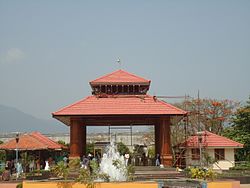| Malampuzha Dam | |
|---|---|
 | |
| Official name |  |
| Location | Palakkad District, Kerala |
| Coordinates | 10°49′49.8″N76°41′1.5″E / 10.830500°N 76.683750°E |
| Construction began | March 1949 |
| Opening date | 9 October 1955 |
| Dam and spillways | |
| Impounds | Malampuzha river |
| Height | 115.06 m |
| Length | 2,069 m |
| Reservoir | |
| Creates | Malampuzha Reservoir |
| Total capacity | 226 million cubic metres [1] (8 tmc ft) |
| Catchment area | 147.63 sq. km. |
Malampuzha Dam is the largest dam and reservoir in Kerala, [2] located near Palakkad, in the state of Kerala in South India, built post-independence by the then Madras state. Situated in the scenic hills of the Western Ghats in the background, it is a combination of a masonry dam with a length of 1,849 metres and an earthen dam with a length of 220 metres making it the longest dam in the state. [3] The dam is 355 feet high and impounds the Malampuzha River, a tributary of Bharathappuzha, Kerala's second-longest river. There is a network of two canal systems that serve the dam's reservoir of 42,090 hectares. [4]

































